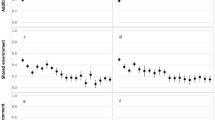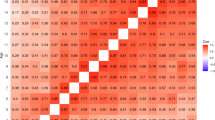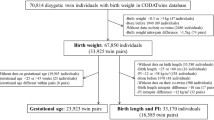Abstract
Owing to high rates of prenatal complications, twins are, on average, substantially smaller than population norms on physical measurements including height, weight, and head circumference at birth. By early childhood, twins are physically average. This study is the first to explore the process of catch-up growth by fitting asymptotic growth models to age-standardized height, weight, and head circumference measurements in a community sample of twins (n = 1281, 52.3% female) followed at up to 17 time points from birth to 15 years. Catch-up growth was rapid over the first year and plateaued around the population mean by early childhood. Shared environmental factors accounted for the majority of individual differences in initial physical size (57.7–65.5%), whereas additive genetic factors accounted for the majority of individual differences in the upper asymptotes of height, weight, and head circumference (73.4–92.6%). Both additive genetic and shared environmental factors were associated with variance in how quickly twins caught up. Gestational age and family SES emerged as important environmental correlates of physical catch-up growth.






Similar content being viewed by others
Data Availability
The data that support the findings of this study are not publicly available. Data may be made available upon reasonable request from the principal investigators, [CB and DD], upon reasonable request.
Code Availability
All R and Mplus scripts supporting this project have been made available on the Open Science Framework (https://osf.io/dsyac/).
References
Albertsson-Wikland K, Karlberg J (1997) Postnatal growth of children born small for gestational age. Acta Paediatr 86(S423):193–195
Ashworth A, Morris SS, Lira PI (1997) Postnatal growth patterns of full-term low birth weight infants in Northeast Brazil are related to socioeconomic status. J Nutr 127(10):1950–1956
Bailey ZD, Krieger N, Agénor M, Graves J, Linos N, Bassett MT (2017) Structural racism and health inequities in the USA: evidence and interventions. Lancet 389(10077):1453–1463
Barker DJ, Osmond C, Forsén TJ, Kajantie E, Eriksson JG (2005) Trajectories of growth among children who have coronary events as adults. N Engl J Med 353(17):1802–1809
Batista RF, Silva AA, Barbieri MA, Simões VM, Bettiol H (2012) Factors associated with height catch-up and catch-down growth among schoolchildren. PLoS ONE 7(3):e32903
Beam CR, Turkheimer E, Finkel D, Levine M, Zandi E, Guterbock T, Giangrande EJ, Ryan L, Pasquenza N, Davis DW (2020) Midlife study of the Louisville twins: connecting cognitive development to biological and cognitive aging. Behav Genet 50(2):73–83
Bélanger SA, Caron J (2018) Evaluation of the child with global developmental delay and intellectual disability. Paediatr Child Health 23(6):403–410
Bertino E, Coscia A, Mombrò M, Boni L, Rossetti G, Fabris C, Spada E, Milani S (2006) Postnatal weight increase and growth velocity of very low birthweight infants. Arch Dis Child Fetal Neonatal Ed 91(5):F349–F356
Blickstein I (2004) Is it normal for multiples to be smaller than singletons? Best Pract Res Clin Obstet Gynaecol 18(4):613–623
Brandt I, Sticker EJ, Lentze MJ (2003) Catch-up growth of head circumference of very low birth weight, small for gestational age preterm infants and mental development to adulthood. J Pediatr 142(5):463–470
Buckler JMH, Green M (2004) A comparison of the early growth of twins and singletons. Ann Hum Biol 31(3):311–332
Buhling KJ, Henrich W, Starr E, Lubke M, Bertram S, Siebert G, Dudenhausen JW (2003) Risk for gestational diabetes and hypertension for women with twin pregnancy compared to singleton pregnancy. Arch Gynecol Obstet 269(1):33–36
Davis DW, Turkheimer E, Finkel D, Beam C, Ryan L (2019) The Louisville Twin Study: past, present and future. Twin Res Hum Genet 22(6):735–740
Demerath EW, Choh AC, Czerwinski SA, Lee M, Sun SS, Chumlea WC, Duren D, Sherwood RJ, Blangero J, Towne B, Siervogel RM (2007) Genetic and environmental influences on infant weight and weight change: the Fels Longitudinal Study. Am J Hum Biol 19(5):692–702
Enders CK (2013) Dealing with missing data in developmental research. Child Dev Perspect 7(1):27–31
Estourgie-van Burk GF, Bartels M, Boomsma DI, Delemarre-van de Waal HA (2010) Body size of twins compared with siblings and the general population: from birth to late adolescence. J Pediatr 156(4):586–591
Fenton TR (2003) A new growth chart for preterm babies: Babson and Benda’s chart updated with recent data and a new format. BMC Pediatr 3(1):1–10
Flegal KM, Graubard BI, Williamson DF, Gail MH (2005) Excess deaths associated with underweight, overweight, and obesity. JAMA 293(15):1861–1867
Frederick IO, Williams MA, Sales AE, Martin DP, Killien M (2008) Pre-pregnancy body mass index, gestational weight gain, and other maternal characteristics in relation to infant birth weight. Matern Child Health J 12:557–567
Gillman MW, Rifas-Shiman S, Berkey CS, Field AE, Colditz GA (2003) Maternal gestational diabetes, birth weight, and adolescent obesity. Pediatrics 111(3):e221–e226
Goldenberg RL, Culhane JF, Iams JD, Romero R (2008) Epidemiology and causes of preterm birth. Lancet 371(9606):75–84
Grimm KJ, Widaman KF (2010) Residual structures in latent growth curve modeling. Struct Equ Model 17(3):424–442
Grimm K, Zhang Z, Hamagami F, Mazzocco M (2013) Modeling nonlinear change via latent change and latent acceleration frameworks: examining velocity and acceleration of growth trajectories. Multivar Behav Res 48(1):117–143
Hack M, Schluchter M, Cartar L, Rahman M, Cuttler L, Borawski E (2003) Growth of very low birth weight infants to age 20 years. Pediatrics 112(1):e30–e38
Hiersch L, Okby R, Freeman H, Rosen H, Nevo O, Barrett J, Melamed N (2020) Differences in fetal growth patterns between twins and singletons. J Matern Fetal Neonatal Med 33(15):2546–2555
Hu LT, Bentler PM (1999) Cutoff criteria for fit indexes in covariance structure analysis: conventional criteria versus new alternatives. Struct Equ Modeling 6(1):1–55
Itabashi K, Mishina J, Tada H, Sakurai M, Nanri Y, Hirohata Y (2007) Longitudinal follow-up of height up to five years of age in infants born preterm small for gestational age; comparison to full-term small for gestational age infants. Early Hum Dev 83(5):327–333
Jelenkovic A, Sund R, Hur YM, Yokoyama Y, Hjelmborg JVB, Möller S et al (2016) Genetic and environmental influences on height from infancy to early adulthood: an individual-based pooled analysis of 45 twin cohorts. Sci Rep 6(1):28496
Jelenkovic A, Sund R, Yokoyama Y, Latvala A, Sugawara M, Tanaka M, Matsumoto S, Freitas DL, Maia JA, Knafo-Noam A, Mankuta D, Abramson L, Ji F, Ning F, Pang Z, Rebato E, Saudino KJ, Cutler TL, Hopper JL, Silventoinen K (2020) Genetic and environmental influences on human height from infancy through adulthood at different levels of parental education. Sci Rep 10(1):1–11
Johnson L, Llewellyn CH, Van Jaarsveld CH, Cole TJ, Wardle J (2011) Genetic and environmental influences on infant growth: prospective analysis of the Gemini twin birth cohort. PLoS ONE 6(5):e19918
Klebanov PK, Evans GW, Brooks-Gunn J (2014) Poverty, ethnicity, and risk of obesity among low birth weight infants. J Appl Dev Psychol 35(3):245–253
Kline J, Stein Z, Susser M (1989) Fetal growth and birth weight: I Indices, patterns and risk factors. In: MacMahon B (ed) Monographs in epidemiology and biostatistics: conception to birth: epidemiology of prenatal development, vol 14. Oxford University Press, New York, pp 208–218
Kowaleski-Jones L, Duncan GJ (2002) Effects of participation in the WIC program on birthweight: evidence from the national longitudinal survey of youth. Am J Public Health 92(5):799–804
Kuczmarski RJ (2002) 2000 CDC Growth Charts for the United States: methods and development (No 246). Department of Health and Human Services, Centers for Disease Control and Prevention, National Center for Health Statistics
Kuklina EV, Ramakrishnan U, Stein AD, Barnhart HH, Martorell R (2006) Early childhood growth and development in rural Guatemala. Early Hum Dev 82(7):425–433
Laar ME, Marquis GS, Lartey A, Gray-Donald K (2018) Reliability of length measurements collected by community nurses and health volunteers in rural growth monitoring and promotion services. BMC Health Serv Res 18(1):1–10
Lee H, Andrew M, Gebremariam A, Lumeng JC, Lee JM (2014) Longitudinal associations between poverty and obesity from birth through adolescence. Am J Public Health 104(5):e70–e76
Liao AW, Brizot MDL, Kang HJ, Assunçao RA, Zugaib M (2012) Longitudinal reference ranges for fetal ultrasound biometry in twin pregnancies. Clinics 67(5):451–455
Livshits G, Peter I, Vainder M, Hauspie R (2000) Genetic analysis of growth curve parameters of body weight, height and head circumference. Ann Hum Biol 27(3):299–312
Llewellyn CH, Van Jaarsveld CH, Johnson L, Carnell S, Wardle J (2010) Nature and nurture in infant appetite: analysis of the Gemini twin birth cohort. Am J Clin Nutr 91(5):1172–1179
Lundgren EM, Cnattingius S, Jonsson B, Tuvemo T (2001) Intellectual and psychological performance in males born small for gestational age with and without catch-up growth. Pediatr Res 50(1):91–96
Marceau K, McMaster MT, Smith TF, Daams JG, van Beijsterveldt CE, Boomsma DI, Knopik VS (2016) The prenatal environment in twin studies: a review on chorionicity. Behav Genet 46(3):286–303
Martin JA, Hamilton BE, Osterman MJ, Driscoll AK (2021) Births: Final Data for 2019. Natl Vital Stat Rep 70(2):1–51
McArdle JJ, Prescott CA (2005) Mixed-effects variance components models for biometric family analyses. Behav Genet 35(5):631–652
McCowan L, Horgan RP (2009) Risk factors for small for gestational age infants. Best Pract Res Clin Obstet Gynaecol 23(6):779–793
Mook-Kanamori DO, Van Beijsterveldt CE, Steegers EA, Aulchenko YS, Raat H, Hofman A, Eilers PH, Boomsma DI, Jaddoe VW (2012) Heritability estimates of body size in fetal life and early childhood. PLoS ONE 7(7):e39901
Morgan PH, Mercer LP, Flodin NW (1975) General model for nutritional responses of higher organisms. PNAS 72(11):4327–4331
Muthén LK, Muthén BO (2017) Mplus Statistical analysis with latent variables User’s guide, 8
Nagahawatte NT, Goldenberg RL (2008) Poverty, maternal health, and adverse pregnancy outcomes. Ann N Y Acad Sci 1136(1):80–85
Oliver ML, Shapiro TM (2006) Black wealth/white wealth. Routledge, New York
Ong KK, Ahmed ML, Emmett PM, Preece MA, Dunger DB (2000) Association between postnatal catch-up growth and obesity in childhood: prospective cohort study. BMJ 320(7240):967–971
Oskovi-Kaplan ZA, Ozgu-Erdinc AS (2018) Prediction of preterm birth: maternal characteristics, ultrasound markers, and biomarkers: an updated overview. J Pregnancy 2018:1–8
Ratkowsky D (1983) Nonlinear regression modelling. Marcel Dekker, New York
Rauh-Hain JA, Rana S, Tamez H, Wang A, Cohen B, Cohen A, Brown F, Ecker JL, Karumanchi SA, Thadhani R (2009) Risk for developing gestational diabetes in women with twin pregnancies. J Matern Fetal Neonatal Med 22(4):293–299
Reichman NE, Pagnini DL (1997) Maternal age and birth outcomes: data from New Jersey. Fam Plann Perspect 29(6):268–295
Ross GS, Krauss AN, Perlman JM (2012) Physical growth and cognitive abilities in concordant versus discordant birth weight twins at three years old. Early Hum Dev 88(9):753–756
Satorra A (2000) Scaled and adjusted restricted tests in multi-sample analysis of moment structures. In: Heijmans RDH, Pollock DSG, Satorra A (eds) Innovations in multivariate statistical analysis: A Festschrift for Heinz Neudecker. Kluwer Academic Publishers, London, pp 233–247
Scharf RJ, Stroustrup A, Conaway MR, DeBoer MD (2016) Growth and development in children born very low birthweight. Arch Dis Child Fetal Neonatal Ed 101(5):F433–F438
Shah PS, Knowledge Synthesis Group on Determinants of LBW/PT births (2010) Parity and low birth weight and preterm birth: a systematic review and meta-analyses. Acta Obstet Gynecol Scand 89(7):862–875
Silventoinen K, Kaprio J, Lahelma E, Koskenvuo M (2000) Relative effect of genetic and environmental factors on body height: differences across birth cohorts among Finnish men and women. Am J Public Health 90(4):627–630
Silventoinen K, Sammalisto S, Perola M, Boomsma DI, Cornes BK, Davis C, Dunkel L, de Lange M, Harris JR, Hjelmborg JVB, Luciano M, Martin NG, Mortensen J, Nistico L, Pedersen NL, Skytthe A, Spector TD, Stazzi MA, Willemsen G, Kaprio J (2003) Heritability of adult body height: a comparative study of twin cohorts in eight countries. Twin Res Hum Genet 6(5):399–408
Simpson LL, Society for Maternal-Fetal Medicine (2013) Twin-twin transfusion syndrome. Am J Obstet Gynecol 208(1):3–18
Singer JD, Willett JB, Willett JB (2003) Applied longitudinal data analysis: modeling change and event occurrence. Oxford University Press, Oxford
Smit DJ, Luciano M, Bartels M, Van Beijsterveldt CE, Wright MJ, Hansell NK, Brunner HG, Estourgie-van Burk GF, de Gues EJC, Martin NG, Boomsma DI (2010) Heritability of head size in Dutch and Australian twin families at ages 0–50 years. Twin Res Hum Genet 13(4):370–380
Sonderlund A, Schoenthaler A, Thilsing T (2021) The association between maternal experiences of interpersonal discrimination and adverse birth outcomes: a systematic review of the evidence. Int J Environ Res Public Health 18(4):1465–1496
Stevenson DK, Verter J, Fanaroff AA, Oh W, Ehrenkranz RA, Shankaran S, Donovan EF, Wright LL, Lemons JA, Tyson JE, Korones SB, Bauer CR, Stoll BJ, Papile LA (2000) Sex differences in outcomes of very low birthweight infants: the newborn male disadvantage. Arch Dis Child Fetal Neonatal Ed 83(3):F182–F185
Sundet JM, Tambs K, Harris JR, Magnus P, Torjussen TM (2005) Resolving the genetic and environmental sources of the correlation between height and intelligence: a study of nearly 2600 Norwegian male twin pairs. Twin ResHum Genet 8(4):307–311
Swamy RS, McConachie H, Ng J, Rankin J, Korada M, Sturgiss S, Embleton ND (2018) Cognitive outcome in childhood of birth weight discordant monochorionic twins: the long-term effects of fetal growth restriction. Arch Dis Child Fetal Neonatal Ed 103(6):F512–F516
United Nations Children’s Fund (2021) UNICEF/WHO/World Bank joint child malnutrition estimates (global and regional) https://data.unicef.org/wp-content/uploads/2021/04/Joint-Malnutrition-Estimates-Regional-and-Global-Estimates-April-2021.xlsx
Upadhyay RP, Naik G, Choudhary TS, Chowdhury R, Taneja S, Bhandari N, Martines JC, Bahl R, Bhan MK (2019) Cognitive and motor outcomes in children born low birth weight: a systematic review and meta-analysis of studies from South Asia. BMC Pediatr 19(1):1–15
van Dommelen P, De Gunst MC, Van Der Vaart AW, Boomsma DI (2004) Genetic study of the height and weight process during infancy. Twin Res Hum Genet 7(6):607–616
van Dommelen P, De Gunst M, Van Der Vaart A, Van Buuren S, Boomsma D (2008) Growth references for height, weight and body mass index of twins aged 0–25 years. Acta Paediatr 97(8):1099–1104
Vohr BR, Tyson JE, Wright LL, Perritt RL, Li L, Poole WK, NICHD Neonatal Research Network (2009) Maternal age, multiple birth, and extremely low birth weight infants. J Pediatr 154(4):498–503
West SG, Taylor AB, Wu W (2012) Model fit and model selection in structural equation modeling. In: Hoyle RH (ed) Handbook of structural equation modeling. The Guilford Press, New York, pp 209–231
Wijlaars LP, Johnson L, van Jaarsveld CH, Wardle J (2011) Socioeconomic status and weight gain in early infancy. Int J Obes 35(7):963–970
Wilson RS (1974) Twins: measures of birth size at different gestational ages. Ann Hum Biol 1(1):57–64
Wilson RS (1979) Twin growth: initial deficit, recovery, and trends in concordance from birth to nine years. Ann Hum Biol 6(3):205–220
Wolfinger R (1993) Covariance structure selection in general mixed models. Commun Stat Simul Comput 22(4):1079–1106
Ye A, Bollen KA (2022) Can we distinguish between different longitudinal models for estimating nonlinear trajectories? Struct Equ Model 29(1):57–69
Yengo L, Vedantam S, Marouli E, Sidorenko J, Bartell E, Sakaue S et al (2022) A saturated map of common genetic variants associated with human height. Nat Genet 610(7933):704–712
Yuan KH, Chan W, Marcoulides GA, Bentler PM (2016) Assessing structural equation models by equivalence testing with adjusted fit indexes. Struct Equ Model 23(3):319–330
Acknowledgements
This work was supported by a grant from the National Institute on Aging (R01AG063949).
Author information
Authors and Affiliations
Contributions
All authors contributed to the conceptualization and design of the study. SW drafted the initial manuscript, led data analysis, and reviewed and revised the manuscript. EG and XT contributed to data analysis and reviewed and revised the manuscript. MP assisted with data cleaning and manuscript preparation. CB, RS, and DD provided input on interpreting the findings and assisted in reviewing and revising the manuscript. ET contributed to data analysis, manuscript preparation, and reviewed and revised the manuscript. All authors approved the final manuscript as submitted and agree to be accountable for all aspects of the work.
Corresponding author
Ethics declarations
Conflict of interest
Sean R. Womack, Christopher R. Beam, Evan J. Giangrande, Rebecca J. Scharf, Xin Tong, Medha Ponnapalli, Deborah W. Davis, Eric Turkheimer have no conflicts of interest to disclose.
Ethical Approval
All procedures performed in the current study were in accordance with the ethical standards of the institutional and/or national research committee and with the 1964 Helsinki declaration and its later amendments or comparable ethical standards. Study procedures were approved by the Institutional Review Board at the University of Louisville.
Consent to Participate
Informed consent was obtained from all individual participants included in this study.
Consent for Publication
Not applicable.
Additional information
Publisher's Note
Springer Nature remains neutral with regard to jurisdictional claims in published maps and institutional affiliations.
Edited by Stacey Cherny.
Supplementary Information
Below is the link to the electronic supplementary material.
Rights and permissions
Springer Nature or its licensor (e.g. a society or other partner) holds exclusive rights to this article under a publishing agreement with the author(s) or other rightsholder(s); author self-archiving of the accepted manuscript version of this article is solely governed by the terms of such publishing agreement and applicable law.
About this article
Cite this article
Womack, S.R., Beam, C.R., Giangrande, E.J. et al. Nonlinear Catch-Up Growth in Height, Weight, and Head Circumference from Birth to Adolescence: A Longitudinal Twin Study. Behav Genet 53, 385–403 (2023). https://doi.org/10.1007/s10519-023-10151-0
Received:
Accepted:
Published:
Issue Date:
DOI: https://doi.org/10.1007/s10519-023-10151-0




